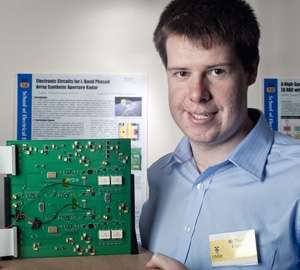NASA-bound graduate solves satellite circuitry

(Phys.org) —An engineering graduate from UNSW who helped develop crucial hardware for a new satellite system has won a scholarship to attend the prestigious NASA Academy.
Thomas Cooney's final-year project for the Australian Centre for Space Engineering Research (ACSER) at UNSW was to design a circuit board to process radar signals for an Australian-developed spacecraft that will monitor the country's water resources.
The proposed satellite would scan 300 kilometre-wide sections of land with a radar beam, measuring in incredibly fine detail the water content in the soil. Cooney's component is integral to making sense of what the radar is detecting.
A satellite's radar works by transmitting intense bursts of high-frequency radio waves at very short intervals of less than a microsecond. The radar then switches into receiver mode and listens for the echo, or returning signal. These radio waves are then processed into images of the earth's surface.
"The new circuit board would allow the radar to reduce its pulse repetition frequency, or the rate at which radio signals are transmitted," says Cooney. "This will ultimately decrease the cost of operation and improve image quality without sacrificing the imaging rate."
Throughout the project he worked closely with an aerospace company in the UK to identify all the system requirements and how to incorporate them efficiently. He then mocked up the circuit schematic using computer software.
"The most rewarding thing about the project was getting the finished board back from the assembler, and holding in my hands a design I had been staring at on a computer screen for months," he said.
And the kicker is that it worked on the very first try. Professor Andrew Dempster, Director of ACSER, says: "Thomas's work is very impressive for an undergraduate and his prize is richly deserved. The circuitry is fundamental to a new way of distributing the electronics across a very large satellite antenna.
"It's a clear example of how space projects both attract and inspire the best engineering students, a message that often falls on deaf ears in Australia."
Cooney's innovative design and corresponding thesis were submitted to the Victorian Space Science Education Centre (VSSEC), which coordinates a student scholarship with NASA.
The VSSEC-NASA Australian Space Prize offers an Australian university student the opportunity to attend the NASA Academy program – a 10-week stint at the Ames Research Centre, where students working alongside leading scientists and engineers on a current NASA project.
Cooney's design won the Data Processing and Electronics category, and after making a detailed submission to NASA, he was selected as the overall winner. He travels to the US on 6 June 2013, and will return at the end of August.
Cooney, who is currently working as a graduate engineer at Cochlear in Sydney, is excited about the internship at NASA, where he will be working on developing a "physical experiment" that could be conducted on the International Space Station.
Provided by University of New South Wales




















